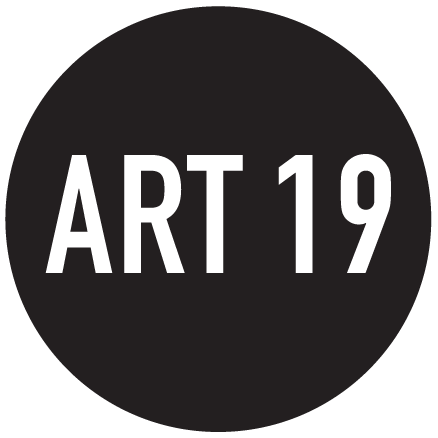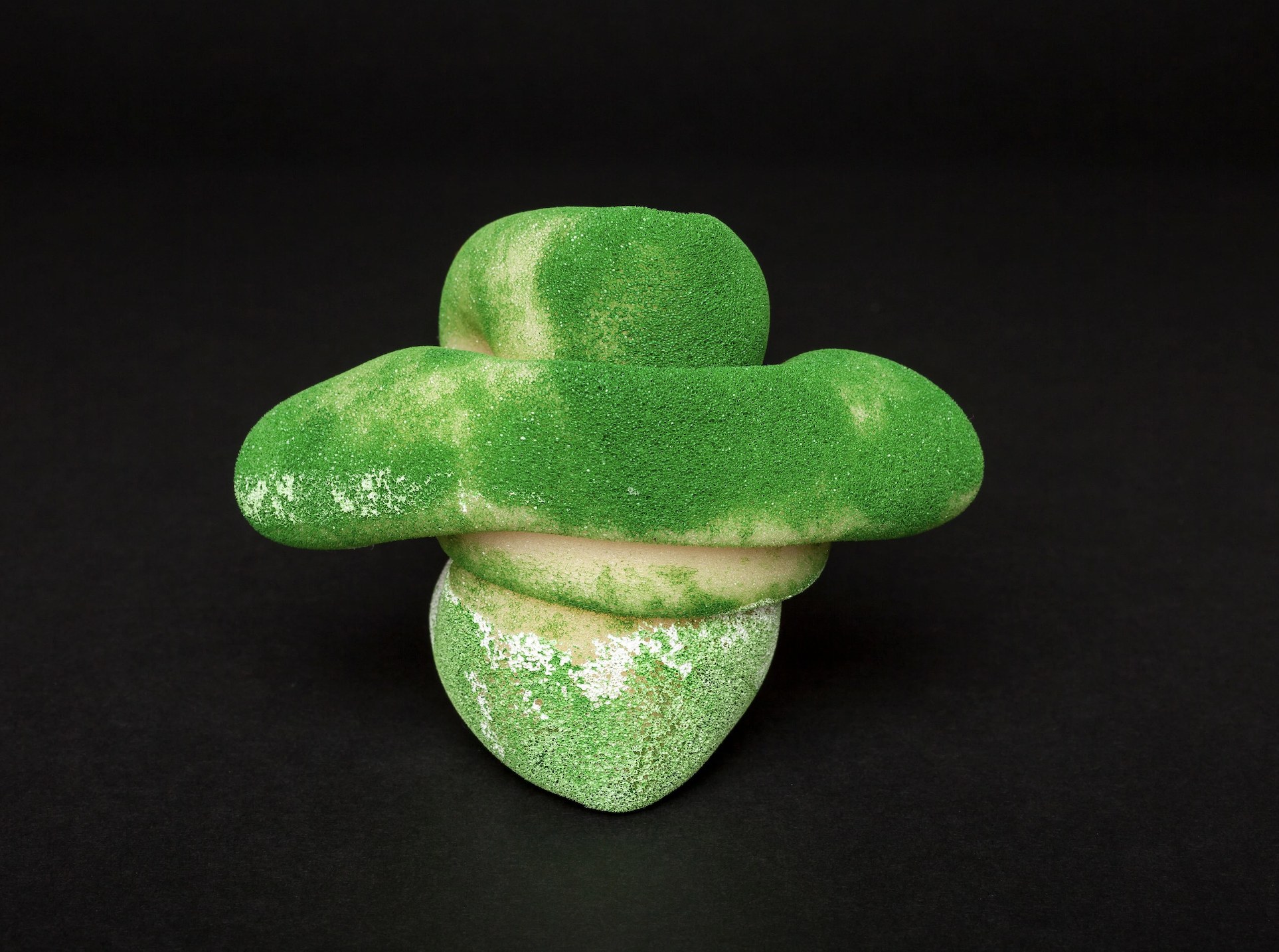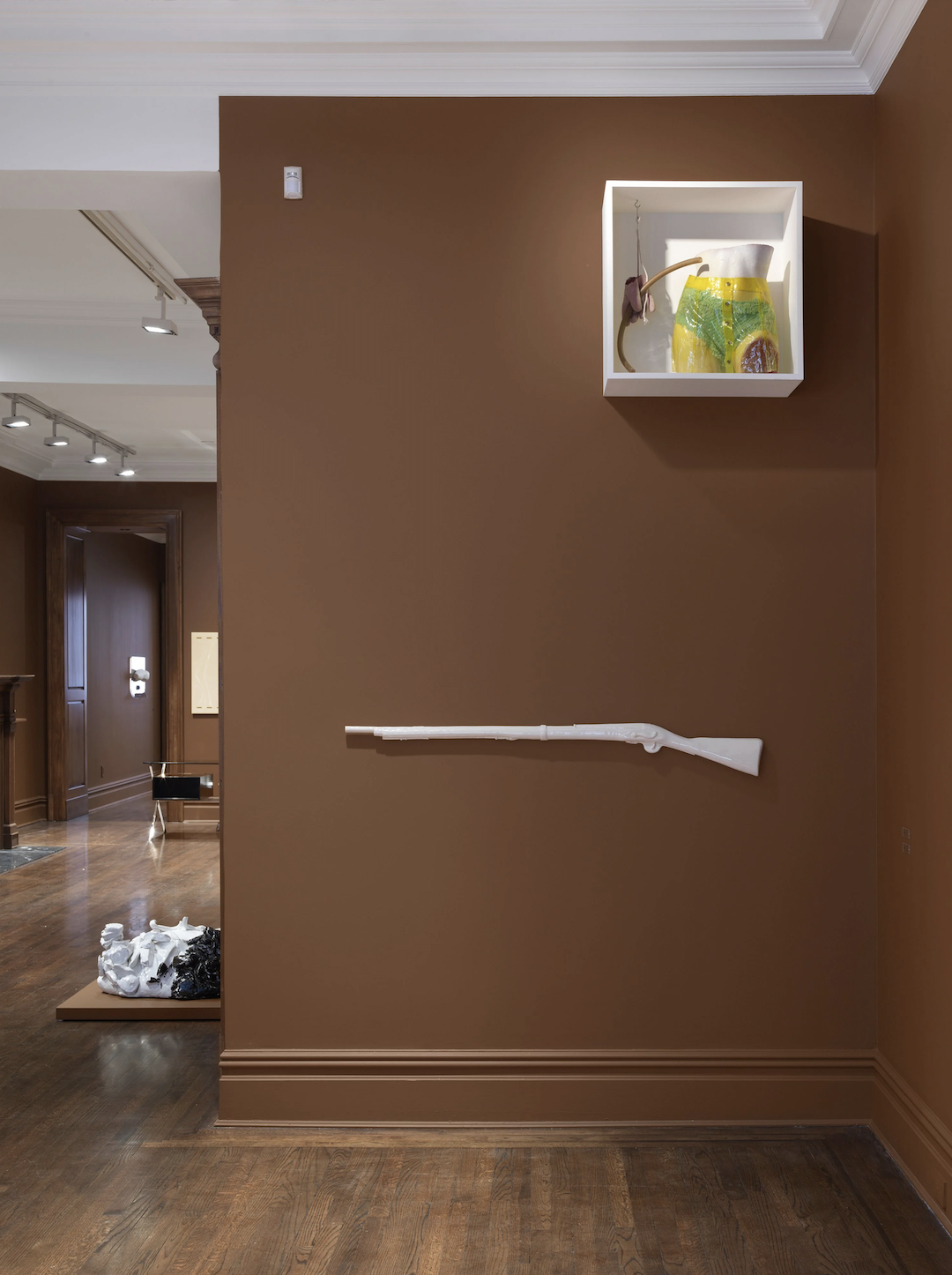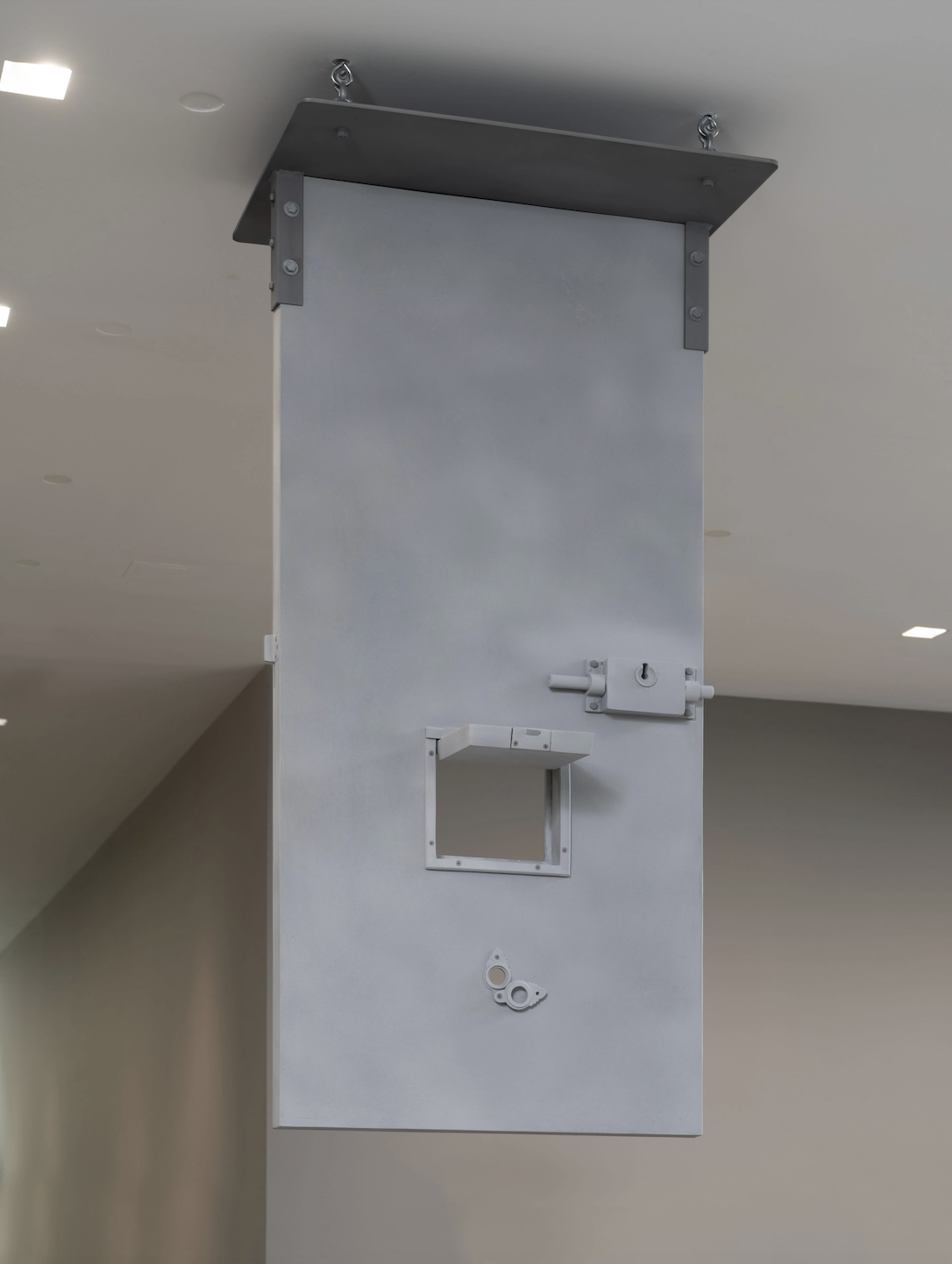OCULA : Rosemarie Trockel’s Inverted Universe
With concurrent shows of Rosemarie Trockel's work at Gladstone Gallery and Sprüth Magers in New York, Aimee Walleston steps into the artist's distinguished, upturned world.
At 72 years old, an artist like Rosemarie Trockel could easily stop trying to make important work, and instead lazily recycle her oeuvre to secure her legacy and cash in on her reputation. The fact that she is crafting exhibitions that, in some ways, surpass those she presented decades ago is a testament to Trockel’s singularity as an artist. Her latest show is a two-part presentation, with works displayed concurrently at Gladstone and Sprüth Magers in New York. There is a wholesome, libidinal pleasure—like a coy-yet-deliberate flash—to be derived from looking at these works. At a time when large swathes of conceptual art assume a crystal clear moral stance and a didactic tone, Trockel plays a different game. While her work often conveys identifiable sociopolitical positions—she is well-known for her feminist critiques of both male artists and feminism itself—her slyness and unpredictability as an artist make encounters with her oeuvre feel like a flirtation, rather than a lesson in how to be a better person.
The aesthetic and conceptual links between the two shows demonstrate Trockel’s interest in crafting phenomenological experiences: the walls of both galleries are painted to match the tones of the floors, highlighting the different characters of each space as well as the works within them. Sprüth Mager’s stately, dark wood floors are complemented by milk chocolate walls, while Gladstone’s cool cement floors are mirrored with grey walls to create an effect reminiscent of a penitentiary, perhaps, or a space station. Enveloped in these hues, viewers feel like they are stepping into a hermetically sealed frame and submitting themselves to the experience of Trockel’s individual perspective.
The Sprüth Magers show, titled Material, features works that toy endlessly with ideas around value, structure, power, and support. As curator Iris Muller-Westermann noted in her essay ‘View from the Other Side’ (2000): ‘While Warhol was interested in the surface of the consumer world, Trockel is interested in the fundamental structures.’ Here, Trockel investigates the question of what is surface and what is structure in sculptural works such as Lol Stein (1990), which takes the form of 11 small, charming clumps of painted plastic foam placed in a plexiglass vitrine, with each handworked clump recalling crude, pungent organic forms like mushrooms, human orifices, and lumps of mouldy cheese.
Rosemarie Trockel, Lol Stein (c. 1990) (detail). © Rosemarie Trockel/VG Bild Kunst, Bonn, 2025. Courtesy the artist and Sprüth Magers.
Trockel seems to relish in the confusion of a ‘cheap’ material being treated as though it were precious and expensive. The question then becomes: What is luxury? If plastic foam is used to pack, ship, and store luxury goods, can it also constitute a luxury artwork? What is the belief structure that denies the substance this status? In the space, there are two wall-mounted benches, also composed partly of foam. Each is titled Château en Espagne (Castle in Spain, 2012 and 2015)—a French idiom that alludes to fanciful hopes or wishes, and is also the title of a 1939 painting by Dutch artist Carel Willink, which has been interpreted as anticipating World War II. Trockel, who grew up in 1950s West Germany, has made a number of works referencing the war, including a portrayal of her mother’s consequent battle with mental illness (The Seven Walls, 1983). Upon entering Sprüth Magers, I was warned not to sit upon these benches: they are artworks and not for sitting. Even though, ontologically speaking, they are in fact for sitting. In the same breath, Mute Servant (2024)—a cracked-glaze ceramic cast of one of the earliest mass-produced muskets—suggests the aestheticised obsolescence, or perhaps castration, of a lethal object. It is not for shooting. Or is it ?
Exhibition view: Rosemarie Trockel, Material, Sprüth Magers, New York (8 May–1 August 2025). Courtesy the artist and Sprüth Magers. Photo: Genevieve Hanson.
At Gladstone, The Kiss presents all newly created works and, perhaps for this reason, has a thymotic charge more immediate than its sister complement. Here, I am met upon entry by a dazzling multimedia floor sculpture, titled Wette gegen sich selbst (Bet Against Yourself) (2005/2024). An entertainment console for aesthetes, it features 48 vinyl record albums—Yoko Ono’s Fly (1971) is most prominent and recognisable, adding to the work’s overall 1970s feel—housed in a low-slung plexiglass bench, with heating elements lining the seat. A smaller, 2005 wall sculpture with the same title, made from a mask and the workings of an inverted clock on silver foil, is included on the right side. This piece is presided over by a series of four large black-and-white portraits, ‘Blind Mother’ (2023–2025), installed in the gallery’s two rooms. All are hung unusually low to the ground, and each features the uncanny, androgynous visage of slightly cowboy-themed humanoid subjects. Created using a combination of Trockel’s own photographs and generative AI, the protagonists of these works are reminiscent of the 1960s model Twiggy crossed with either a Swedish skateboarder or a young Harry Dean Stanton. The title inspires immediate pathos until one picks it apart: perhaps AI itself is the ‘blind mother’ here, birthing creations it cannot recognise as its own. A similar critical inquiry is implied in the show’s titular work, The Kiss (2025)—an aluminium sculpture composed of two flat-screen televisions facing each other, passionately ‘kissing’ with their backs to the world. Conjuring Czech-Brazilian philosopher Vilém Flusser’s observation, in his book Into the Universe of Technical Images (1985), that communication has ‘evolved from direct interaction with the world to mediation through various technologies,’ The Kiss conceptualises the ultimate Flusserian pornography.
Rosemarie Trockel, Bird's Eye View (2025). Aluminium, bronze, iron. 185 x 90 x 50 cm. © Rosemarie Trockel/Artists Rights Society, New York. Courtesy Sprüth Magers and Gladstone. Photo: David Regen.
The most poetic work in the presentation, Bird’s Eye View (2025), is one that registers Trockel at her most Trockelian. Formed from the cast of a prison-cell door that has been inverted and suspended from the gallery’s ceiling, the piece aligns with Trockel’s long and deep exploratory history relative to the aesthetic and cultural forms of animals. At A Cosmos, Trockel’s last big exhibition in New York, held at the New Museum in 2012, she included filmmaker Wladyslaw Starewicz’s The Cameraman’s Revenge (1912), which stars beetles, alongside Replace Me (2011), a digital print of Gustave Courbet’s explicit painting, The Origin of the World (1866), with a tarantula hovering above the pubis, and a series of three paintings, Less sauvage than others (2012), made by an orangutan named Tilda. In Bird’s Eye View, the slot in the door, which is normally used for prisoner restraint or to deliver trays of food, is reimagined as the opening to a bird feeder. Rather than making a straightforward moral comment about human injustice (though that’s likely part of the conceptual thinking around this piece), Trockel’s inversion of this object gives viewers a chance to contemplate less obvious questions that I believe are integral to the understanding of Trockel’s purview: What if the cultural products created by non-human animals could be valued in the same way that fine art and industrial products are valued by human animals? What happens when you turn an object on its head, and completely reconceptualise its use meaning as non-anthropocentric?
There is one oft-repeated Trockel quote, ‘Every animal is a female artist,’ which she issued in 1993 as a rejoinder to fellow German conceptualist Joseph Beuys’ assertion that ‘Every man is an artist.’ Inverted, Beuys’ quote reads ‘Every artist is a man,’ and I think one can discern the obvious problems with that statement. Trockel often pokes fun at the trope of the male artistic genius, and I have a feeling that the two identical photographs in the Gladstone presentation, which depict a man with a bandaged ear à la Vincent van Gogh (both Ally, 2025), are at least tangential reminders of her mischievous responses to that mythology.
Rosemarie Trockel, Ally (2025). Print on paper, mounted on alu-dibond. 71.4 x 71.4 x 2.9 cm (framed). © Rosemarie Trockel/Artists Rights Society, New York. Courtesy Sprüth Magers and Gladstone. Photo: David Regen.
In the spirit of Trockel and her penchant for playful inversions, let’s switch the subject and object of Trockel’s own quote: ‘Every female artist is an animal.’ I have a feeling Trockel would like this. As an artist whose work is often described as inscrutable and impenetrable, I think Trockel is less deliberately mysterious than many might think. If, instead of comparing her work to the “great masters” of canonical art history that she often sets before her crosshairs, we connect her pieces to non-human cultural products like wasp’s nests and birdsong, we might have a better chance of “getting” exactly what Trockel’s work is about. Perhaps, then, Trockel’s work is simply an invitation to inversion itself. Maybe all it asks is for us to align with an understanding of the universe where traditional human logic can be spun around and stood on its head. —[O]
Written by Aimee Walleston for https://ocula.com/













